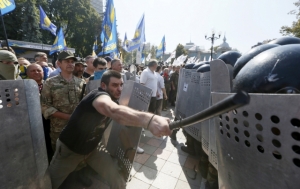Violent Clashes Outside Ukraine’s Parliament Kill One and Injure 90
Ukraine’s extreme nationalists are a small but dangerous force. On Monday a group of protesters – many of them supporters of Ukraine’s far-right Svoboda (“Freedom”) party – threw grenades at national guardsman outside the parliament building in Kiev. One guardsman was killed and roughly 90 were injured.
The display of violence was sparked by the Ukrainian parliament’s passage of a legislative act that would grant autonomy to the breakaway regions in the country’s east. The bill is seen by many nationalists as a capitulation to separatist rebels and their Kremlin backers.
Thirty people were arrested following the deadly demonstration. The slain guardsman was 25 years old.
Interior Minister Arsen Avakov identified the man responsible as a member of Svoboda and blamed the party for stoking the violence. “Tell me, how does Svoboda differ from the bastards who shoot at our national guard at the front?” he wrote.
Svoboda holds six seats in the country’s 450-seat parliament.
Two hundred sixty-five deputies voted in favor in the first reading of the “decentralization” draft law, a bill supported by President Petro Poroshenko. The legislation would grant a package of self-governance rights to the breakaway regions surrounding the cities of Donetsk, Luhansk and Kharkiv. A second reading of the bill will need to pass with 300 votes for it to become law.
If ultimately passed, regional governments will be allowed to use Russian as an official language and amnesty will be granted to individual separatists having taken part in military action against government forces.
The legislation was opposed by former Prime Minister Yulia Tymoshenko, who fears that granting autonomy is unlikely to bring an end to fighting and will further erode the government’s authority in the east. “This is a diametrically opposed process which forces us to lose territory,” she said. “He [Putin] needs war in Ukraine. Our task in the vote is to get back to negotiations on the right road to bring peace, not the illusion of peace.”
More than 6,800 people have been killed as a result of fighting between government forces and Kremlin-backed separatists that began in April 2014.
Analysis by Steven Jones
Last days in Ukraine’s capital city of Kiev has been of dramatic nature. It has become known that three members of the country’s National Guard has died from injuries after Monday’s violent protests outside the parliament.
According to BBC, the clashes - involving nationalists - erupted after MPs gave initial backing to reforms granting more autonomy to rebel-held eastern Ukraine. It seems that the first death was reported after a grenade was thrown by a protester marching against a ceasefire agreed between Ukrainian government troops and the pro-Russian separatists is reported to be holding.
Violence had escalated in the Eastern regions of Donetsk and Luhansk in recent weeks, but the two sides agreed last week that from 1 September all violations of a February truce would cease.
The government says it was boosting security in the capital, deploying 2,000 police and national guards on the streets and an armored vehicle on 4 key routes in the city center.
Reportedly, police have detained about 30 people suspected of involvement, including a Svoboda member who confessed to throwing a grenade.
The protest was organized by the populist Radical Party and ultra-nationalist Svoboda (Freedom) party – opposing to any concession to the separatists. The violence has involved about 140 people injured, more than half of them national guardsmen.
In the meantime, the Radical Party has pulled out of the ruling coalition and joined the opposition MPs in parliament. The violence followed an unruly parliamentary debate, and a first-reading vote to back the decentralization bill of Ukraine, which was agreed by the February agreement of Minsk, 2015.
According to the deal, more rights need to be conveyed to the rebel-held areas of Donetsk and Luhansk.
Ukrainian President Petro Poroshenko said the violence was “a stab in the back” while Svoboda accused the National Guard and police of attacking the protesters, saying this had triggered the clashes.
Looking at the process of fulfillment of the truce, the last summer has been quite hot for both sides, as fighting between Ukrainian army forces and the rebels has escalated. The one-day real ceasefire has been agreed last week to halt the violence on 1 September, the day children in the region return to school.
BBC’s reports: Almost 7,000 people have died since the conflict in eastern Ukraine erupted.
GT analysis:
Ukraine has been a battlefield for Russian regular military units along with the so-called rebels on the ground against Ukraine’s governmental forces, who stand to secure the country’s sovereignty and territorial integrity.
Russia, for escalating the situation in Eastern Ukraine and annexing Ukraine’s peninsula of Crimea, has had an array of economic sanctions imposed by the West - led by the United States. The sanctions have unarguably weakened Russian economy, while Putin’s government is making some contrary statements as if ‘they were strong enough’ to endure all of the pressure exerted on them.
Will the situation further escalate? How can the current level of European security be assessed?
Photo from www.thenation.com
Joseph Larsen












